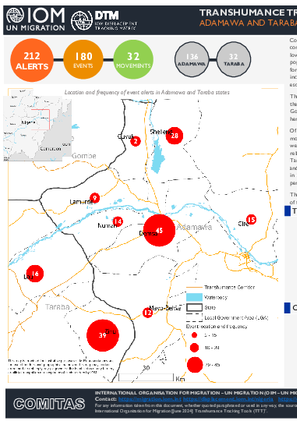-
Countries
-
Data and Analysis
-
Special Focus
-
Crisis Responses
Nigeria — Transhumance Tracking Tool Report — Early Warning Dashboard 25 — Adamawa and Taraba states (May 2024)

Contact
DTM Nigeria, iomnigeriadtm@iom.int
Language
English
Location
Nigeria
Period Covered
May 01 2024
May 31 2024
Activity
- Survey
- Mobility Tracking
- Event Tracking
Conflicts between farmers and herders in North-East Nigeria and other Sahel regions are driven by a combination of environmental and demographic factors, including desertification, climate change impacts, and low rainfall which reduces the availability of suitable land for farming and transhumance activities. Rapid population growth further exacerbates these issues by increasing the demand for food, shelter, and security for both humans and livestock. This heightened competition for scarce natural resources often leads to incidents like farming on cattle routes, crop destruction, farm damage, and water pollution, which often escalate into violent confrontations between farming and herding communities.
The Transhumance Tracking Tool (TTT), a component of IOM's Displacement Tracking Matrix (DTM with the support of community key informants) operationalized the Early Warning System in nine selected Local Government Areas (LGAs) in Adamawa and Taraba states. This system collects alerts related to farmer-herder conflicts.Of the 212 alerts recorded in May, 180 alerts (85%) were event-related, while 32 (15%) were related to movements. In Demsa, Lamurde, Girei, Shelleng, and Numan LGAs in Adamawa state, all instances of alerts were event-related. In Mayo-Belwa LGA, 92 per cent were event-related and 8 per cent were movement-related. Also, Guyuk LGA reported 17 per cent event-related alerts and 83 per cent movement-related. In Taraba state, Zing and Lau LGAs reported 83 per cent and 55 per cent event-related alerts, and 17 per cent and 45 per cent movement-related alerts, respectively. Disaggregated ward-level data indicates that Zing ward in Zing LGA in Taraba state and Kodompti ward in Numan LGA of Adamawa state reported the highest percentage of events, 8 and 7 per cent of the total alerts respectively.
